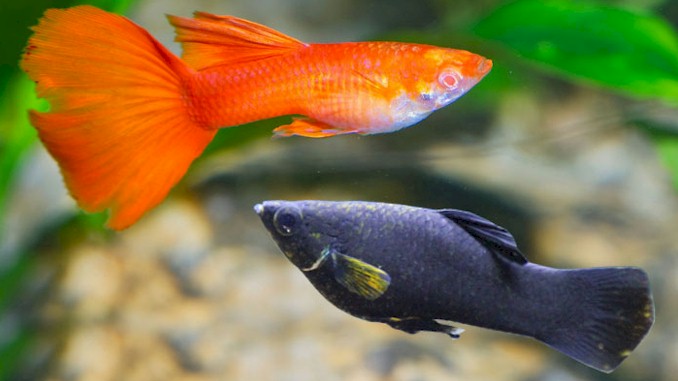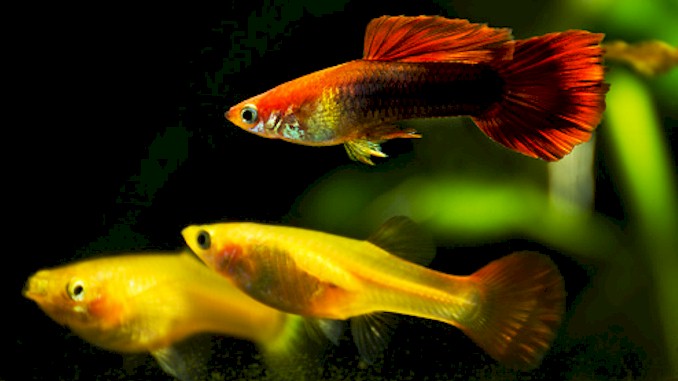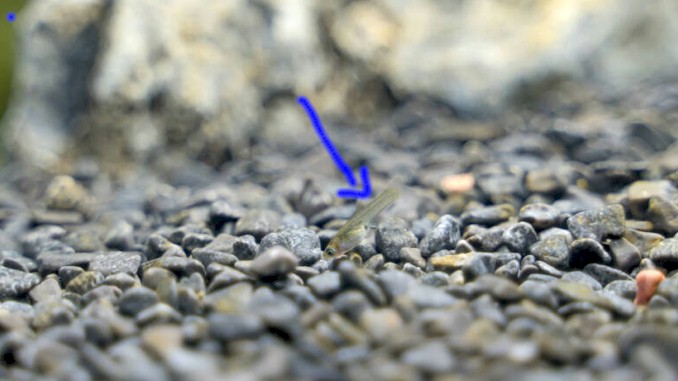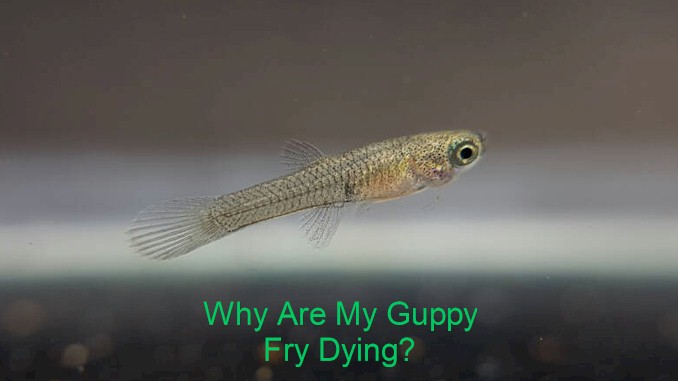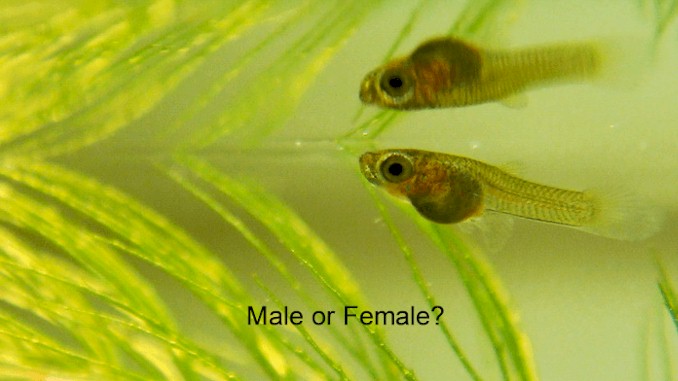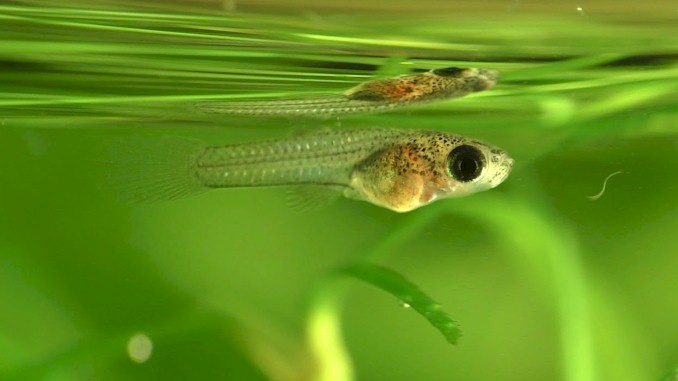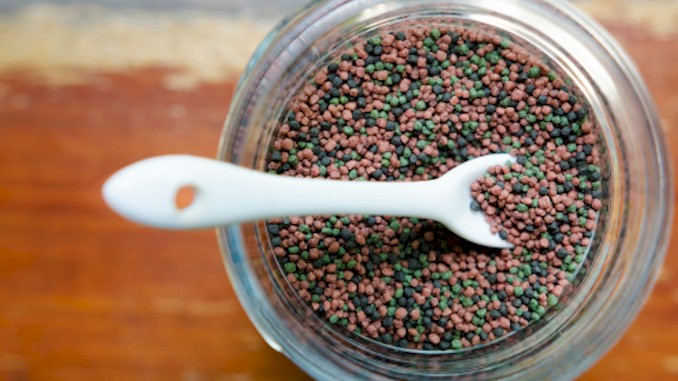Guppy-Molly Breeding: A Match Made in Fish Heaven
If you are a fish enthusiast and you have guppies and mollies in your aquarium, you might be wondering if they can breed and how to breed them successfully. You might have heard that these two species are closely related and can produce hybrid offspring, but is that true? And if so, how can you encourage them to mate and care for their fry? In this blog post, I will answer all these questions and more. I have been keeping and breeding guppies and mollies for over 10 years, so I have the experience and knowledge to help you achieve your breeding goals. Whether you want to create your own unique strains of guppies or mollies, or you just want to enjoy the beauty and diversity of these colorful fish, this post will guide you through the process step by step.
Guppies and mollies are both members of the family Poeciliidae, which includes live-bearing fish that can interbreed with each other. Therefore, guppies and mollies can breed and produce fertile hybrid offspring that have traits from both parents. However, breeding guppies and mollies requires certain conditions and precautions to ensure the health and well-being of the fish and their fry.
Breeding guppies and mollies can be a rewarding and enjoyable hobby, but it also requires some knowledge and skills to do it right. In the following sections, I will share with you some of the best tips and tricks that I have learned over the years on how to breed guppies and mollies successfully. You will learn how to select the best breeding pairs, how to set up a suitable breeding tank, how to feed and care for your pregnant fish and their fry, how to deal with potential problems and diseases, and much more. By following these guidelines, you will be able to create your own beautiful and healthy guppy-molly hybrids that will amaze you and your friends. So don’t stop reading now, because there is a lot more to discover about this fascinating topic!
What are guppies and mollies and why breed them?
Guppies and mollies are two types of fish that belong to the same family, Poeciliidae. They are both native to the Americas, but they have been introduced to many other parts of the world as aquarium fish. They are both livebearers, which means they give birth to live young instead of laying eggs. They are both omnivorous, which means they eat a variety of foods including algae, plants, insects and detritus.
Guppies and mollies are very popular among fish enthusiasts because they are easy to care for, peaceful and colorful. They come in many different shapes, sizes and patterns that can add beauty and diversity to any aquarium. They are also very active and curious fish that will explore every corner of their tank.
One of the reasons why some people want to breed guppies and mollies is because they can produce hybrid offspring that have traits from both parents. This can result in some unique and stunning combinations that are not found in nature. For example, some guppy-molly hybrids may have a sailfin like a molly but a fancy tail like a guppy. Some may have a mix of colors from both species or even new colors that neither parent has.
Another reason why some people want to breed guppies and mollies is because they enjoy the challenge and satisfaction of creating their own strains of fish. By selecting the best breeding pairs, they can improve the genetics and appearance of their fish over generations. They can also experiment with different crossbreeding methods and see what results they get.
Breeding guppies and mollies can also be a fun way to learn more about these fascinating fish. By observing their behavior, anatomy, physiology and development, you can gain a deeper understanding of their biology and ecology. You can also share your knowledge and experience with other hobbyists who share your passion.
As you can see, guppies and mollies are two types of fish that have many similarities but also some differences. They can breed with each other and produce hybrid offspring that have characteristics from both parents. Breeding guppies and mollies can be an enjoyable hobby for many reasons such as creating unique strains of fish, improving their quality or simply learning more about them.
How to choose the best guppies and mollies for breeding
Choosing the right fish is an important step in breeding guppies and mollies successfully. You need to consider several factors such as color, strain, type, health and gender ratio. Here are some tips on how to select the best guppies and mollies for breeding:
- Color: Guppies and mollies come in a wide range of colors and patterns that can make them very attractive and appealing. If you want to create your own unique hybrids, you may want to choose fish that have contrasting or complementary colors. For example, you could pair a black molly with a yellow guppy or a blue molly with a red guppy. Alternatively, you could choose fish that have similar colors if you want to create more uniform hybrids. For example, you could pair a silver molly with a silver guppy or a gold molly with a gold guppy.
- Strain: Guppies and mollies have been selectively bred for many generations to produce different strains that have distinct features and traits. Some of these strains are more desirable than others because they have better quality, appearance or performance. If you want to breed high-quality fish, you may want to consult a reputable breeder who can provide you with purebred or pedigree fish that have proven genetics. Some examples of popular strains are sailfin mollies, balloon mollies, fancy guppies and cobra guppies.
- Type: Guppies and mollies can be classified into different types based on their body shape, fin shape and size. Some types are more suitable for breeding than others because they have better compatibility, fertility or survivability. For example, short-finned mollies are easier to breed than sailfin mollies because they have less finnage that can get damaged or tangled during mating. Similarly, round-tailed guppies are more fertile than sword-tailed guppies because they have less deformities in their gonopodium (the male reproductive organ).
- Health: Guppies and mollies should be healthy and disease-free before breeding. You should check their physical condition regularly and look for any signs of illness or injury such as spots, wounds, fungus, parasites or abnormal behavior. You should also quarantine any new fish for at least two weeks before introducing them to your breeding tank to prevent any infections from spreading. You should also feed your fish a balanced diet that contains high-quality protein, vitamins and minerals to boost their immune system and reproductive health.
- Gender ratio: Guppies and mollies are both sexually dimorphic species which means that males and females look different from each other. Males are usually smaller but more colorful than females while females are larger but duller than males. Males also have a modified anal fin called gonopodium which they use to fertilize the females internally while females have a triangular anal fin called gravid spot which darkens when they are pregnant. The ideal gender ratio for breeding is one male for every two or three females. This will ensure that every female gets fertilized without being harassed too much by the males.
If you can follow my tips above, you will increase your chances of producing healthy and beautiful hybrid offspring.
How to prepare a breeding tank for guppies and mollies
Preparing a breeding tank for guppies and mollies is essential to ensure their health, safety and comfort during the mating process. A breeding tank should be separate from the main tank where you keep your other fish. It should also have the following features:
- Size: The size of the breeding tank depends on how many guppies and mollies you want to breed. A general rule of thumb is to provide at least 10 gallons of water per pair of fish. However, you may need a larger tank if you want to breed more fish or if your fish are very active and need more space.
- Lids: A lid is important to prevent your fish from jumping out of the tank during breeding. It also helps to maintain a stable temperature and humidity level in the tank.
- Substrate: The substrate is the material that covers the bottom of the tank. You can use sand or gravel as a substrate for your breeding tank. However, some breeders prefer to use no substrate at all because it makes it easier to clean the tank and remove any waste or debris. The choice is up to you and your preference.
- Decorations: Decorations such as rocks, driftwood, flower pots or caves can provide hiding places for your fish. This can reduce stress and aggression among your fish and allow them to get used to each other before mating. Decorations can also enhance the appearance of your tank and create a natural environment for your fish.
- Plants: Plants are beneficial for your breeding tank because they provide oxygen, filter toxins, prevent algae growth and serve as spawning sites for some fish. You can use live or artificial plants for your breeding tank. Live plants are more beneficial but they require more care and maintenance than artificial plants. Some examples of plants that are suitable for guppies and mollies are java moss, hornwort, anubias, java ferns and water lettuce.
- Heater: A heater is necessary to keep the water temperature stable and optimal for your guppies and mollies. Guppies prefer a temperature range of 72°F to 84°F while mollies prefer a temperature range of 72°F to 78°F. You can use an adjustable heater that allows you to set the desired temperature according to your fish’s needs.
- Filter system: A filter system is important to keep the water clean and clear for your guppies and mollies. A filter system removes waste, ammonia, nitrite, nitrate and other harmful substances from the water. It also aerates the water and creates water movement. You can use a sponge filter, a hang-on-back filter, a power filter or a canister filter for your breeding tank. However, you should avoid using filters that create too much current or suction as they may harm or stress your fish.
That’s all features you should look for when you prepare a breeding tank for guppies and mollies, when you could apply them in your practice, you will create a suitable environment for them to mate successfully.
How to tell when your guppies and mollies are ready to mate
Guppies and mollies are both livebearers, which means they give birth to live young instead of laying eggs. They are also prolific breeders, which means they can mate frequently and produce many offspring. However, there are some signs that can help you tell when your guppies and mollies are ready to mate:
- Gender: The first step is to identify the gender of your guppies and mollies. Males and females have different physical features that can help you distinguish them. Males are usually smaller but more colorful than females. Males also have a modified anal fin called gonopodium which they use to fertilize the females internally. Females have a triangular anal fin called gravid spot which darkens when they are pregnant.
- Age: The next step is to determine the age of your guppies and mollies. Both species reach sexual maturity at around 3 months of age. However, some factors such as water temperature, diet and genetics can affect their growth rate and maturity level. You should avoid breeding fish that are too young or too old as they may have lower fertility or higher mortality rates.
- Behavior: The final step is to observe the behavior of your guppies and mollies. Both species exhibit certain behaviors that indicate their readiness to mate. Males will chase females around the tank, display their fins, nudge their gonopodium against their abdomen or perform courtship dances. Females will show interest by swimming near males, arching their backs or flicking their tails. If you see these behaviors happening frequently in your tank, it means your guppies and mollies are ready to mate.
Now you have learned all the points that help you to ensure that your guppies and mollies are ready to mate, you will be able to plan your breeding schedule and expect some hybrid fry soon.
How to care for your pregnant guppies and mollies
Caring for your pregnant guppies and mollies is vital to ensure their health and well-being during this delicate period. Pregnant guppies and mollies have special needs that you need to address to prevent any complications or risks. Here are some tips on how to care for your pregnant guppies and mollies:
- Monitor water parameters: The water quality in your breeding tank should be optimal for your guppies and mollies. You should check the water temperature, pH, ammonia, nitrite and nitrate levels regularly and make any necessary adjustments. The ideal water temperature for guppies is 72°F to 84°F while for mollies it is 72°F to 78°F. The ideal pH range for both species is 7.0 to 8.5. The ammonia, nitrite and nitrate levels should be as close to zero as possible.
- Provide a comfortable environment: Pregnant guppies and mollies may require more hiding spots or plants to provide a sense of security. They may also become more shy or aggressive than usual due to hormonal changes. You should provide them with enough space and cover to avoid stress and harassment from other fish. You should also avoid any sudden changes in lighting, noise or movement that could startle them.
- Feed a balanced diet: Pregnant guppies and mollies need a varied and nutritious diet that contains high-quality protein, vitamins and minerals to support embryo development. You should feed them small amounts of food several times a day rather than one large meal once a day. You can use flake food as a primary base but supplement it with live or frozen foods such as brine shrimp, bloodworms, daphnia or tubifex worms. You can also offer them some vegetable matter such as algae wafers, spirulina flakes or blanched lettuce.
- Watch for signs of labor: Pregnant guppies and mollies will show some signs that indicate they are close to giving birth. These signs include a very distended belly, a darkened gravid spot (a patch of skin near the anal fin that indicates pregnancy), reduced appetite, increased breathing rate, erratic swimming behavior or hiding at the bottom of the tank. When you notice these signs, you should prepare for the arrival of the fry by moving the mother fish to a separate tank or net breeder if possible.


API Aquarium Test Kit
That all I can share with you about how to care for your pregnant guppies and mollies, if you consumed and applied them properly, you will ensure that they have a smooth and safe pregnancy and deliver healthy and lively fry.
How to recognize and separate the guppy-molly fry
Guppy-molly fry are the hybrid offspring of guppies and mollies. They are born live and fully-formed, but they are very small and vulnerable. You need to recognize and separate them from their parents and other fish as soon as possible to prevent them from being eaten or injured. Here are some tips on how to recognize and separate the guppy-molly fry:
- Recognize the signs of labor: The first step is to know when your pregnant guppy or molly is about to give birth. You can tell by observing her physical changes and behaviors. She will have a very distended belly, a darkened gravid spot (a patch of skin near the anal fin that indicates pregnancy), reduced appetite, increased breathing rate, erratic swimming behavior or hiding at the bottom of the tank. When you notice these signs, you should prepare for the arrival of the fry by moving her to a separate tank or net breeder if possible.
- Look for the fry: The next step is to look for the fry after your guppy or molly gives birth. The fry will usually swim near the surface of the water or hide among plants or decorations. They will be very tiny (about 1/4 inch long) and transparent with some faint coloration. They may resemble either their guppy or molly parent or have a mix of features from both. You can use a magnifying glass or a flashlight to spot them more easily.
- Separate the fry: The final step is to separate the fry from their mother and other fish as soon as you can. You can use a small net or a turkey baster to gently scoop them up and transfer them to a separate tank or container. Make sure that the water parameters (temperature, pH, ammonia, etc.) are similar to their original tank. You should also provide them with some cover such as plants or floating objects to make them feel secure1.
That’s all, following steps above, you will ensure that they survive and grow into healthy and beautiful fish.
How to feed and grow your guppy-molly fry
Feeding and growing your guppy-molly fry is crucial to ensure their survival and development. Guppy-molly fry are very small and delicate, so they need special food and care that suit their needs. Here are some tips on how to feed and grow your guppy-molly fry:
- Feed them frequently: Guppy-molly fry have a high metabolism and a fast growth rate, so they need to be fed several times a day. You should feed them at least three times a day, but preferably four to eight times a day. You should feed them small amounts of food that they can finish within a few minutes to avoid overfeeding or water pollution.
- Feed them appropriate food: Guppy-molly fry need high-quality protein, vitamins and minerals to support their growth and health. You should feed them food that is specially designed for fry or finely crushed flakes that are suitable for guppies and mollies. You can also supplement their diet with live or frozen foods such as baby brine shrimp, microworms, daphnia or tubifex worms. You can also offer them some vegetable matter such as algae wafers, spirulina flakes or blanched lettuce.
- Feed them varied food: Guppy-molly fry benefit from a varied diet that provides them with different nutrients and flavors. You should rotate their food sources every day or every other day to prevent boredom or nutritional deficiencies. You can also try some homemade foods such as egg yolk paste (made from hard-boiled egg yolk mixed with water) which is rich in protein and easy to digest.
- Provide clean water: Guppy-molly fry need clean water to thrive and avoid diseases. You should perform regular water changes (10% to 20% every week) to remove waste, ammonia, nitrite, nitrate and other harmful substances from the water. You should also use a sponge filter or other appropriate filtration system for your tank size that does not create too much current or suction that could harm your fry.
- Provide optimal conditions: Guppy-molly fry need optimal conditions to grow well and stay healthy. You should keep the water temperature between 72°F and 84°F for guppies and between 72°F and 78°F for mollies using an aquarium heater. You should also keep the pH range between 7.0 and 8.5 using test kits and buffers if needed. You should also provide enough light (8 to 12 hours per day) and oxygen (using an air stone) for your fry.
If you follow these tips above well, you will have a big chance that your hybrid will reach maturity and become a healthy and beautiful fish.
How to identify the different types of guppy-molly hybrids
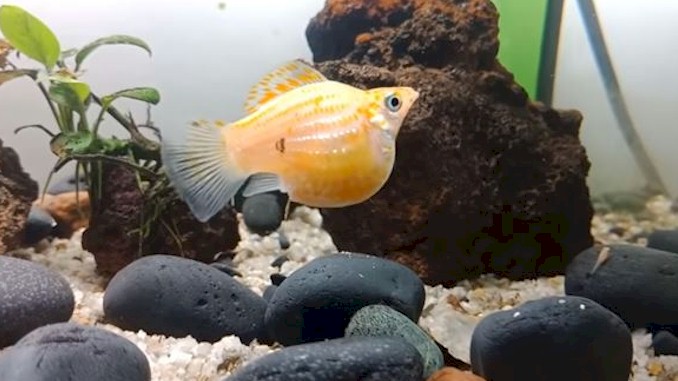

Guppy-molly hybrids are the offspring of guppies and mollies, two species of fish that belong to the same family (Poeciliidae) and can interbreed with each other. Guppy-molly hybrids can have a mix of features from both parents, such as body shape, fin shape, color and pattern. However, identifying the different types of guppy-molly hybrids can be challenging because they can vary widely depending on their genetic makeup and environmental factors. Here are some tips on how to identify the different types of guppy-molly hybrids:
- Look at their names: Guppy-molly hybrids have different names depending on which parent is male and which is female. If the male is a guppy and the female is a molly, the hybrid is called a Golly. If the male is a molly and the female is a guppy, the hybrid is called a Muppy. These names can help you narrow down which type of hybrid you have based on their parentage.
- Look at their size: Guppy-molly hybrids tend to inherit their size from their molly parent rather than their guppy parent. This means that they are usually larger than purebred guppies but smaller than purebred mollies. The average size of a guppy-molly hybrid is about 2 inches long.
- Look at their fins: Guppy-molly hybrids can have different types of fins depending on which parent they resemble more. Some may have long and flowing fins like guppies while others may have short and rounded fins like mollies. Some may also have unique fin shapes such as sailfins or swordtails that are characteristic of certain strains of mollies or guppies.
- Look at their colors: Guppy-molly hybrids can have a wide range of colors and patterns that can be influenced by both parents. Some may have solid colors such as black, silver or gold while others may have spots, stripes or patches of different colors. Some may also have iridescent scales that reflect light in rainbow hues. The coloration of guppy-molly hybrids can change over time as they mature or due to environmental factors such as water quality or lighting.
- Look at their behavior: Guppy-molly hybrids can also exhibit different behaviors depending on which parent they inherit more traits from. Some may be more active and curious like guppies while others may be more shy or aggressive like mollies. Some may also show signs of courtship or mating behavior such as chasing, displaying or nudging with their gonopodium (the male reproductive organ).
By following these tips, you will be able to appreciate their diversity and beauty.
How to improve the genetics and appearance of your guppy-molly hybrids
Guppy-molly hybrids are the result of crossbreeding guppies and mollies, two species of fish that can interbreed because they belong to the same family (Poeciliidae). Guppy-molly hybrids can have a variety of features from both parents, such as body shape, fin shape, color and pattern. However, guppy-molly hybrids may also have some drawbacks such as lower fertility, weaker immunity or deformities. If you want to improve the genetics and appearance of your guppy-molly hybrids, here are some tips on how to do so:
- Choose high-quality parents: The quality of your guppy-molly hybrids depends largely on the quality of their parents. You should choose healthy and attractive fish that have proven genetics and pedigree from reputable breeders. You should avoid breeding fish that are sick, injured or have any defects or diseases. You should also avoid breeding fish that are closely related (such as siblings or cousins) as this can increase the risk of inbreeding and genetic problems.
- Provide optimal conditions: The conditions in your tank can affect the health and development of your guppy-molly hybrids. You should provide them with optimal conditions such as clean water, stable temperature, appropriate pH, adequate filtration and aeration. You should also provide them with enough space, cover and hiding places to reduce stress and aggression. You should also avoid any sudden changes in lighting, noise or movement that could startle them.
- Feed a balanced diet: The diet of your guppy-molly hybrids can influence their growth and appearance. You should feed them a balanced diet that contains high-quality protein, vitamins and minerals to support their growth and health. You should feed them small amounts of food several times a day rather than one large meal once a day. You can use flake food as a primary base but supplement it with live or frozen foods such as brine shrimp, bloodworms, daphnia or tubifex worms. You can also offer them some vegetable matter such as algae wafers, spirulina flakes or blanched lettuce.
- Select desirable offspring: The offspring of your guppy-molly hybrids may vary widely in their features depending on their genetic makeup. Some may resemble more their guppy parent while others may resemble more their molly parent. Some may also have unique features such as sailfins or swordtails that are characteristic of certain strains of mollies or guppies. You can select desirable offspring by observing their physical traits, behavior, and performance. You can keep those that have attractive colors, patterns, fin shapes, and body shapes. You can also keep those that are healthy, active, and fertile. You can cull those that have dull colors, poor patterns, deformed fins, or abnormal body shapes. You can also cull those that are sick, weak, or sterile.
You can see, it’s not that hard, right? You just need to follow these tips on how to improve the genetics and appearance of your guppy-molly hybrids, you will be able to create beautiful fish that reflect both parents’ qualities.
Common problems and diseases in guppy-molly breeding and how to prevent them
Guppy-molly breeding is the process of crossbreeding guppies and mollies, two species of fish that can interbreed because they belong to the same family (Poeciliidae). Guppy-molly breeding can produce hybrid offspring that have a mix of features from both parents. However, guppy-molly breeding can also pose some problems and diseases that can affect the health and well-being of both parents and offspring. Here are some common problems and diseases in guppy-molly breeding and how to prevent them:
- Stress: Stress is a major factor that can weaken the immune system of guppies and mollies and make them more susceptible to infections, parasites and diseases. Stress can be caused by various factors such as poor water quality, overcrowding, temperature fluctuations, noise, lighting changes or harassment by other fish. To prevent stress, you should provide your guppies and mollies with optimal conditions such as clean water, stable temperature, appropriate pH, adequate filtration and aeration. You should also provide them with enough space, cover and hiding places to reduce stress and aggression. You should also avoid any sudden changes in lighting, noise or movement that could startle them.
- Parasites: Parasites are organisms that live on or inside another organism (the host) and cause harm to it. Guppies and mollies can be infected by various types of parasites such as protozoa (single-celled organisms), worms (roundworms or flatworms), crustaceans (such as copepods or anchor worms) or fungi (such as Saprolegnia). Some common parasitic diseases that affect guppies and mollies are white spot disease (Ichthyophthirius multifiliis), velvet disease (Oodinium limneticum), fin rot (Aeromonas hydrophila), gill flukes (Dactylogyrus spp.), camallanus worms (Camallanus cotti) or hexamitiasis (Hexamita spp.). These parasites can cause symptoms such as white spots, gold dusting, ragged fins, redness, swelling, gasping, scratching or holes in the body. To prevent parasitic infections, you should quarantine new fish before adding them to your tank, perform regular water changes, use a suitable filter system, avoid overfeeding, remove dead fish immediately, inspect your fish daily for any signs of illness, and treat any infected fish with appropriate medications.
- Bacterial infections: Bacterial infections are caused by bacteria that invade the body of guppies and mollies and cause damage to their tissues. Guppies and mollies can be infected by various types of bacteria such as Aeromonas spp., Pseudomonas spp., Vibrio spp., Mycobacterium spp., Flexibacter spp. or Streptococcus spp. Some common bacterial diseases that affect guppies and mollies are columnaris disease ( Flexibacter columnaris), mouth fungus ( Flexibacter cytophaga), dropsy ( Aeromonas salmonicida), red blood spot disease ( Pseudomonas fluorescens), viral hemorrhagic septicemia ( VHSV), popped eye disease ( Aeromonas hydrophila) or tuberculosis ( Mycobacterium marinum). These bacteria can cause symptoms such as cotton-like growths, ulcers, sores, bleeding spots, swollen abdomen, bulging eyes, skin lesions or weight loss. To prevent bacterial infections,
you should maintain good water quality, avoid overcrowding, feed a balanced diet, use sterilized equipment, avoid cross-contamination, isolate sick fish, and treat any infected fish with antibiotics or antibacterial agents.
I really hope that you will never run into situations in which you have to deal with all these challenges. But if it’s time you have to face them, the tips above could help you get things out, and you can ensure that your fish stay healthy and happy.
Wow, that’s a lot! I really didn’t imagine that I had written a lengthy article on this topic. I hope it can really help you.

